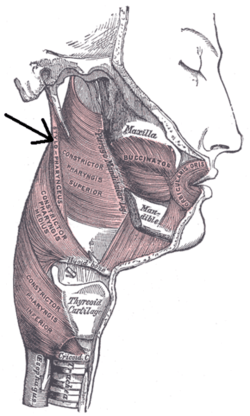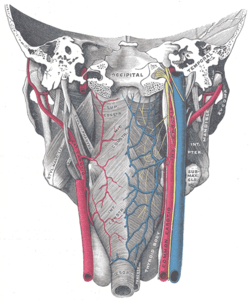Stylopharyngeus muscle
| Stylopharyngeus muscle | |
|---|---|
 Muscles of the pharynx and cheek. (Stylopharyngeus visible at center left.) | |
| Details | |
| Latin | musculus stylopharyngeus |
| Precursor | 3rd Branchial Arch |
| Styloid process (temporal) | |
| thyroid cartilage (larynx) | |
| glossopharyngeal nerve (CN IX) | |
| Actions | elevate the larynx, elevate the pharynx, swallowing |
| Identifiers | |
| Gray's | p.1143 |
| MeSH | A02.633.567.800 |
| Dorlands /Elsevier | m_22/12550987 |
| TA | A05.3.01.114 |
| FMA | 46664 |
| Anatomical terms of muscle | |
The stylopharyngeus is a muscle in the head that stretches between the temporal styloid process and the pharynx.
Structure
The stylopharyngeus is a long, slender muscle, cylindrical above, flattened below. It arises from the medial side of the base of the temporal styloid process, passes downward along the side of the pharynx between the superior pharyngeal constrictor and the middle pharyngeal constrictor, and spreads out beneath the mucous membrane.
Some of its fibers are lost in the constrictor muscles while others, joining the palatopharyngeus muscle, are inserted into the posterior border of the thyroid cartilage.
The glossopharyngeal nerve runs on the lateral side of this muscle, and crosses over it to reach the tongue.
Innervation
Stylopharyngeus is the only muscle in the pharynx innervated by the glossopharyngeal nerve (CN IX) and is done by its single motor branch, which supplies special visceral efferent (SVE) fibers to it.
Development
Embryological origin is the third pharyngeal arch
Function
The stylopharyngeus:
- elevates the larynx
- elevates the pharynx
- dilates the pharynx to permit the passage of a large food bolus, thereby facilitating swallowing
See also
- This article uses anatomical terminology; for an overview, see anatomical terminology.
- Stylohyoid muscle
- Styloglossus muscle
Additional images
-

Stylopharyngeus muscle.
-

Left temporal bone. Inferior surface.
-

The cartilages of the larynx. Posterior view.
-

Side view of the larynx, showing muscular attachments.
-

Extrinsic muscles of the tongue. Left side.
-

Muscles of the pharynx, viewed from behind, together with the associated vessels and nerves.
-
Stylopharyngeus muscle
-
Stylopharyngeus muscle
-
Stylopharyngeus muscle
-
Stylopharyngeus muscle
References
This article incorporates text in the public domain from the 20th edition of Gray's Anatomy (1918)
External links
| ||||||||||||||||||||||||||||||||||||||||||||||||



